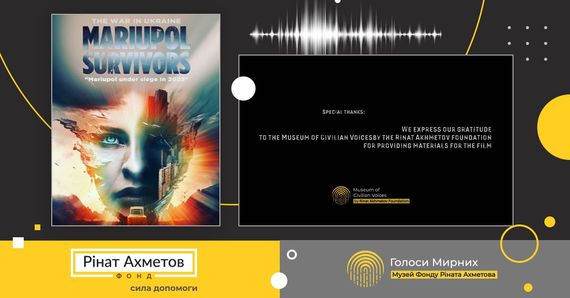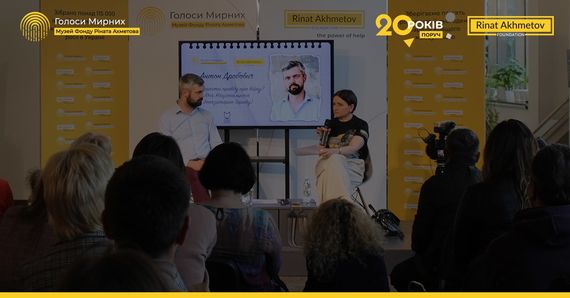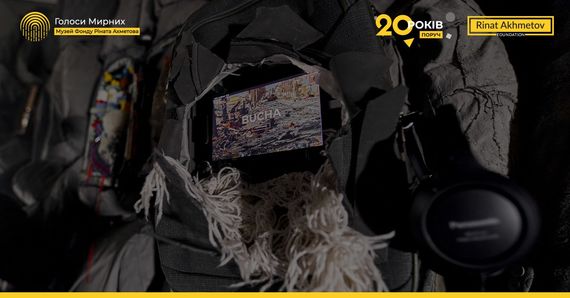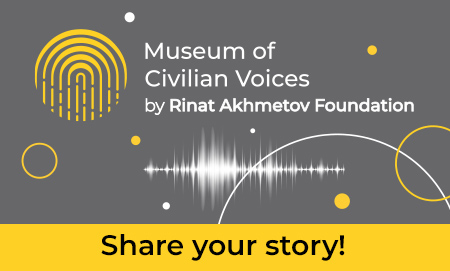A Film With Stories From the Museum of Civilian Voices of the Rinat Akhmetov Foundation Took Part in the Santa Fe Film Festival: Exclusive Interview With the Authors

The annual film event The Santa Fe International Film Festival took place in the city of Santa Fe, in the United States. At the festival, a Ukrainian documentary film Mariupol Survivors was presented. The work includes some fragments of stories from the collection of the Museum of Civilian Voices of the Rinat Akhmetov Foundation.
The authors of the film plan to shoot a series of projects about the cities of Ukraine during the war called The War in Ukraine.
Before the war, the director of the film Maria Mikhno worked as a director of the post-production department at some top Ukrainian TV channels. Screenwriter, journalist and voiceover artist Anastasia Bazdyreva worked as a presenter, actress and screenwriter at some leading Ukrainian TV channels. Maria and Anastasia together answered the questions from the Museum of Civilian Voices of the Rinat Akhmetov Foundation.
How did you come up with the idea and why you decided to make a film?
After crossing the US border, we realized how far the topic of the russian war in Ukraine was from the Americans. They were unaware of the killings of civilians, especially children. We realized that something must be done about it, and our weapons are audio-visual works. We decided to tell the story of Mariupol first, because this small resort town has a very large number of victims among its civilian population. This is a huge disaster for Ukraine and for the rest of humanity, and another proof of the criminal war of the russian army against Ukraine.
How did you work on the film?
We worked almost without sleep for nine days. There were some challenges with the filming process because the shooting partly took place online. We did not have the opportunity to come to some of the locations, as well as to be present on the set at all. However, we had a well-knit team charged for success. Each of us did the most that depended on him or her. For example, our cameraman Denys Nilogov not only acted according to the storyboard scripted by the director, but also oriented himself on the spot and suggested how to improve the filmed scene or image, based on the conditions of a particular location. Anastasia masterfully established contacts with people from Mariupol who agreed to give interviews. And despite the fact that the recording was made via a video call, people were able to get at ease and share their stories with open heart.
What was the hardest part?
To meet the deadlines. After all, we had only nine days to produce the film and submit the finished work to the festival. Clearly, we had a script written in advance, and we had contacts of some people who were ready to share their stories, but the filming process and post-production had to fit into this short term. And we did it.
How difficult is it to record the stories of civilians about the war?
Murder, especially mass murder, is not a natural thing. It is difficult to ask about the death of people’s loved ones, their acquaintances and even strangers. The hardest part is that you will never understand the depth of these people’s pain because you have not been through it. Every story is unique and full of horrors that no one deserves. And here it is important to tell Mariupol residents and all other victims of the war that we sympathize with all our hearts, that we are on their side, no matter what happens, and no matter what decisions they have to make. And to repeat the obvious thing, that the blame for all that lies with the russians. And most importantly, before the interview, we always explained our main goal: to tell the world about russian crimes, to do everything possible to stop the aggressor country.
How did the Museum of Civilian Voices of the Rinat Akhmetov Foundation help in your work on the film?
The Museum helped to show the massive scale of russian terrorism in Ukraine and in Mariupol. We had two main stories from families that survived in Mariupol, but there are thousands of such families. There is not a single person in this city who would not be affected by the war. The Museum of Civilian Voices collected these stories during the entire wartime — and now we have the opportunity to let the world know that these are not some single cases, this is not an exception to the rules, but rather a mass terror and genocide of the Ukrainian people.
How did it happen that the film got to the prestigious festival in Santa Fe?
It is a double luck. We learned about the festival when our film was in the script stage, but after we provided the materials on the development of our project, the organizers of the Santa Fe International Film Festival believed in us.
The stories that became part of the film Mariupol Survivors are included in the archive of the Museum of Civilian Voices of the Rinat Akhmetov Foundation. This is the world’s largest collection of stories from Ukrainian civilians who suffered from the war. The Museum’s archive now has more than 60,000 stories. Share your story on https://civilvoicesmuseum.org/ or by calling a toll-free hotline 0 (800) 509 001.



